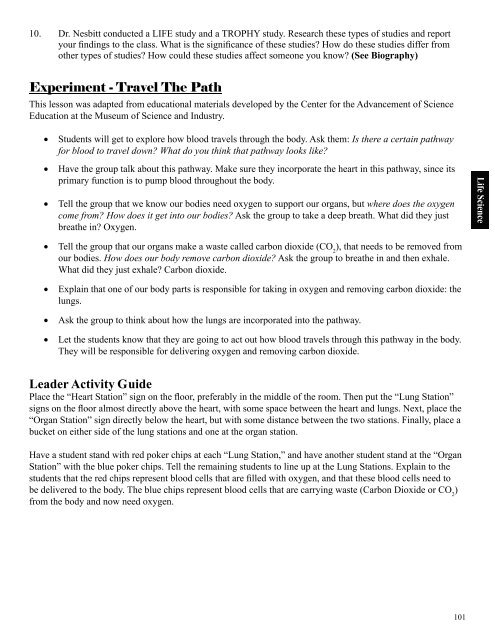ScienceMakers Toolkit Manual - The History Makers
ScienceMakers Toolkit Manual - The History Makers
ScienceMakers Toolkit Manual - The History Makers
Create successful ePaper yourself
Turn your PDF publications into a flip-book with our unique Google optimized e-Paper software.
10. Dr. Nesbitt conducted a LIFE study and a TROPHY study. Research these types of studies and report<br />
your fi ndings to the class. What is the signifi cance of these studies? How do these studies differ from<br />
other types of studies? How could these studies affect someone you know? (See Biography)<br />
Experiment - Travel <strong>The</strong> Path<br />
This lesson was adapted from educational materials developed by the Center for the Advancement of Science<br />
Education at the Museum of Science and Industry.<br />
• Students will get to explore how blood travels through the body. Ask them: Is there a certain pathway<br />
for blood to travel down? What do you think that pathway looks like?<br />
• Have the group talk about this pathway. Make sure they incorporate the heart in this pathway, since its<br />
primary function is to pump blood throughout the body.<br />
• Tell the group that we know our bodies need oxygen to support our organs, but where does the oxygen<br />
come from? How does it get into our bodies? Ask the group to take a deep breath. What did they just<br />
breathe in? Oxygen.<br />
• Tell the group that our organs make a waste called carbon dioxide (CO 2 ), that needs to be removed from<br />
our bodies. How does our body remove carbon dioxide? Ask the group to breathe in and then exhale.<br />
What did they just exhale? Carbon dioxide.<br />
• Explain that one of our body parts is responsible for taking in oxygen and removing carbon dioxide: the<br />
lungs.<br />
• Ask the group to think about how the lungs are incorporated into the pathway.<br />
• Let the students know that they are going to act out how blood travels through this pathway in the body.<br />
<strong>The</strong>y will be responsible for delivering oxygen and removing carbon dioxide.<br />
Leader Activity Guide<br />
Place the “Heart Station” sign on the fl oor, preferably in the middle of the room. <strong>The</strong>n put the “Lung Station”<br />
signs on the fl oor almost directly above the heart, with some space between the heart and lungs. Next, place the<br />
“Organ Station” sign directly below the heart, but with some distance between the two stations. Finally, place a<br />
bucket on either side of the lung stations and one at the organ station.<br />
Have a student stand with red poker chips at each “Lung Station,” and have another student stand at the “Organ<br />
Station” with the blue poker chips. Tell the remaining students to line up at the Lung Stations. Explain to the<br />
students that the red chips represent blood cells that are fi lled with oxygen, and that these blood cells need to<br />
be delivered to the body. <strong>The</strong> blue chips represent blood cells that are carrying waste (Carbon Dioxide or CO 2 )<br />
from the body and now need oxygen.<br />
101<br />
Life Science










